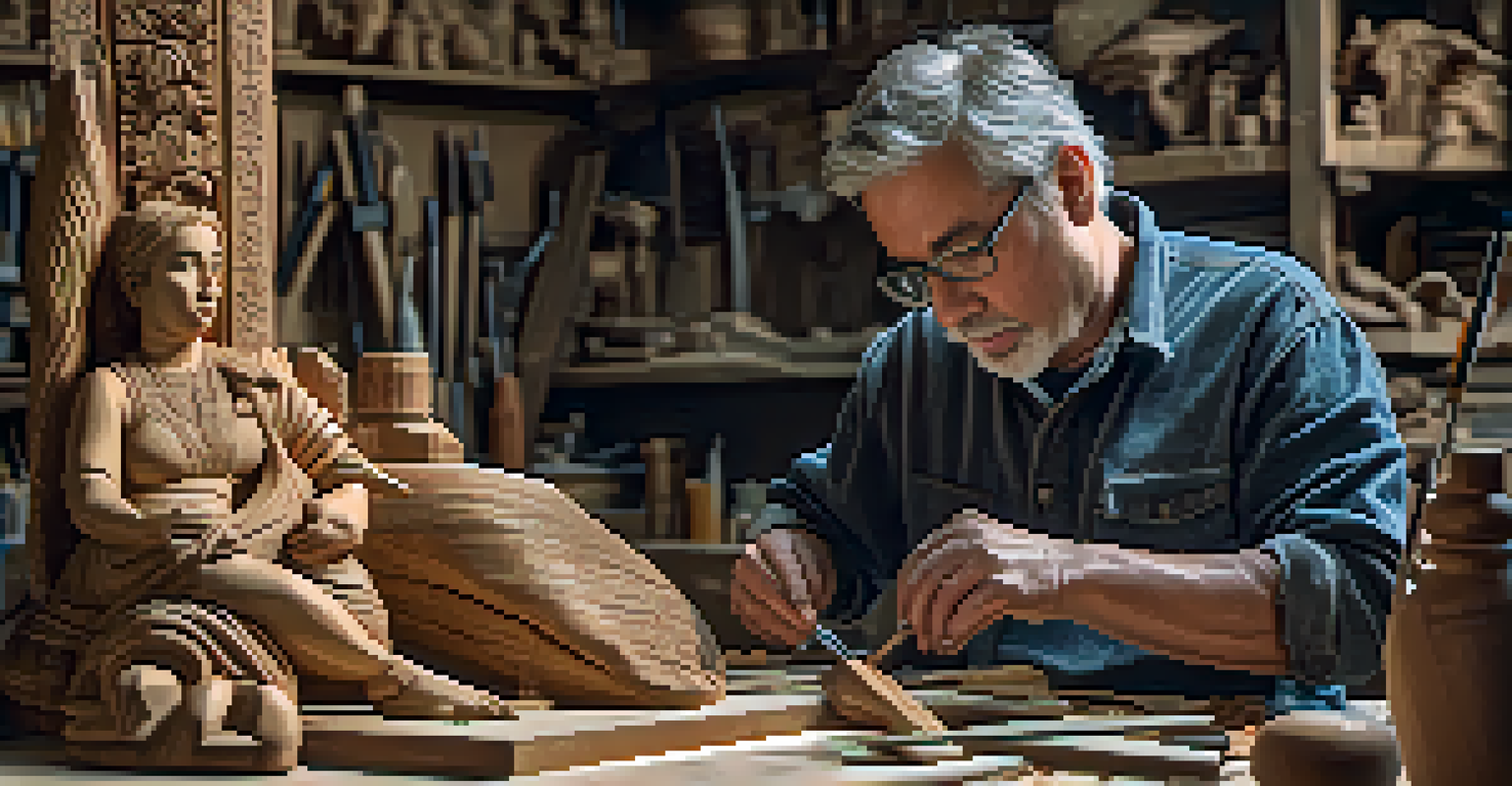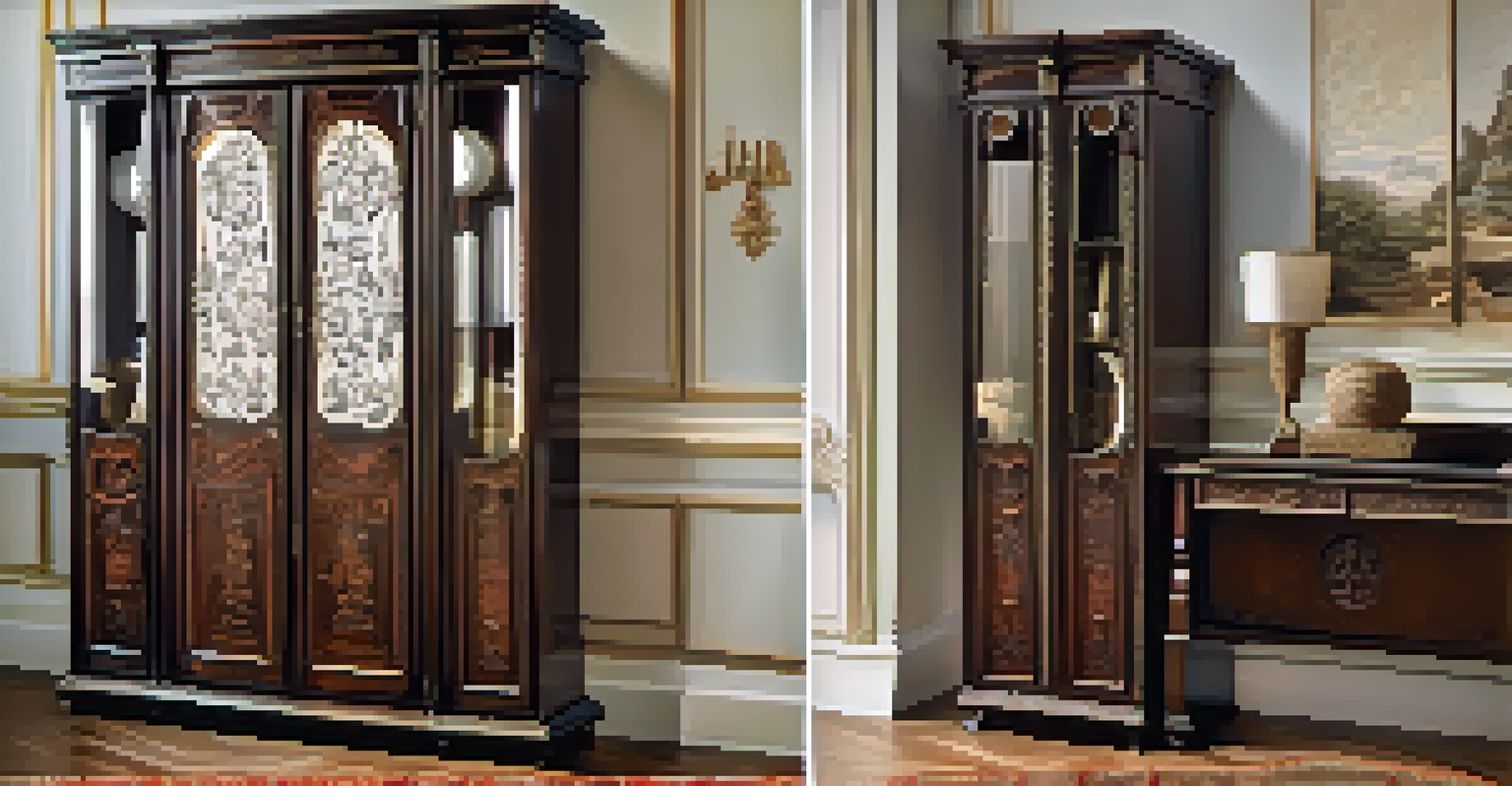Preserving Original Carvings During Furniture Restoration

Understanding the Importance of Original Carvings in Furniture
Original carvings are like fingerprints for furniture; they tell a story of craftsmanship and history. These intricate details not only enhance the beauty of a piece but also add significant value. Preserving these carvings is essential for maintaining the integrity and identity of the furniture, especially in antique pieces.
Every piece of furniture has a story to tell, and the beauty of original carvings is that they are the storytellers.
When you restore furniture, the temptation to cover or replace worn-out carvings can be strong. However, such actions can erase the unique character that makes the piece special. Instead, a thoughtful approach to restoration ensures that these original elements remain intact, allowing the furniture’s heritage to shine through.
Moreover, original carvings can provide insights into the style and techniques of the period in which the furniture was made. By preserving them, restorers contribute to the ongoing appreciation and understanding of historical craftsmanship, making it a valuable undertaking.
Assessing the Condition of Carvings Before Restoration
Before diving into restoration, it's crucial to assess the condition of the carvings. Look for signs of wear, damage, or decay, noting how these factors might affect your restoration process. Understanding what you’re working with helps you decide whether to conserve or restore the carvings.

Sometimes, carvings might only need cleaning or minor repairs to restore their former glory. In other cases, you may find that they require more extensive work, such as filling in missing details or stabilizing loose sections. Documenting the condition thoroughly can guide your restoration efforts and ensure you make informed decisions.
Value of Original Carvings
Original carvings enhance furniture's beauty and historical significance, making their preservation crucial.
This assessment phase is also an opportunity to research the original techniques used in creating the carvings. Knowing whether they were hand-carved or machine-made can influence your approach, as different methods might require different restoration strategies.
Choosing the Right Tools and Materials for Restoration
The tools and materials you select for your restoration project can significantly impact the outcome. For delicate carvings, using fine chisels and specialized carving tools is essential. These tools allow for precision work, ensuring that you can preserve the details without causing further damage.
Preservation is not just about saving the past; it's about ensuring future generations can appreciate our history.
Additionally, the choice of materials, such as wood fillers or adhesives, plays a pivotal role. Opt for materials that match the original wood or are specifically designed for antique restoration. This ensures that any repairs blend seamlessly with the existing carvings and do not disrupt the aesthetic.
Always prioritize using non-toxic and reversible materials whenever possible. This approach not only protects the original integrity of the carvings but also ensures that future restorers can work on the piece without complications.
Cleaning Techniques for Carved Furniture
Cleaning carved furniture requires a gentle touch to avoid damaging the delicate details. Start with a soft brush or cloth to remove dust and debris from the carvings. This step is crucial, as dirt can accumulate in crevices, making restoration more challenging later on.
For deeper cleaning, consider using a mild soap solution, but avoid soaking the wood. Instead, dampen your cloth slightly and wipe the carvings carefully, ensuring you don’t saturate the wood. Rinse with another cloth dampened in clean water, then dry thoroughly to prevent moisture damage.
Assessing Carvings Before Work
Evaluating the condition of carvings is essential to determine the best restoration approach.
Lastly, after cleaning, consider applying a suitable wax or polish to protect the carvings. This not only enhances their appearance but also provides a layer of protection against future wear and tear.
Repairing Damaged Carvings: Techniques and Tips
When faced with damaged carvings, there are various techniques you can employ to repair them. For minor chips or cracks, wood filler can be an effective solution. Choose a filler that matches the wood’s color and grain, allowing you to restore its original look.
For more extensive damage, you might need to carve new details to match the original design. This process requires patience and skill, as you’ll want to ensure the new carvings blend seamlessly with the existing ones. Taking your time here is vital to achieving a cohesive look.
Always remember to document your repairs, noting what you did and why. This information can be invaluable for future restorations, helping others understand the work that has been done and preserving the furniture’s history.
Finishing Touches: Protecting Original Carvings After Restoration
Once the restoration is complete, protecting the original carvings should be your next priority. Applying a finish, such as varnish or oil, helps seal the wood and protects it from moisture and dirt. However, be careful to choose finishes that enhance rather than obscure the carvings.
Regular maintenance is also essential in preserving the beauty of the carvings. Periodically dust the furniture and apply a fresh coat of wax or polish as needed. This routine care can extend the life of the restoration and maintain the piece's overall appearance.
Benefits of Professional Restorers
Consulting professional restorers ensures high-quality results and maintains the integrity of original carvings.
Finally, consider the furniture's environment. Keeping it away from direct sunlight, extreme temperatures, or high humidity levels can prevent further deterioration. A little care goes a long way in ensuring that those original carvings remain beautiful for generations to come.
The Role of Professional Restorers in Preserving Carvings
While DIY restoration can be rewarding, there’s immense value in consulting professional restorers, especially when it comes to preserving intricate carvings. These experts possess the skills and experience needed to navigate complex restoration challenges. They can assess the condition of carvings and recommend the best approaches tailored to the piece.
Professional restorers also have access to specialized tools and materials that may not be readily available to the average person. This access can make a significant difference in achieving high-quality results while maintaining the integrity of the original carvings.

Moreover, they can provide insight into the history and techniques used in the piece, enriching your understanding and appreciation of the furniture. Ultimately, collaborating with professionals can result in a restoration that honors the craftsmanship of the past while ensuring the piece is preserved for future generations.